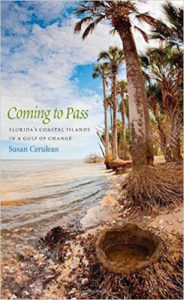For the majority of human beings – particularly those living in the developed nations – there exists an unnatural veil between themselves and the natural world. For some of these the veil is slightly opaque and allows perception that there is something on the other side of it; for others it is as heavy as a velvet curtain – obscuring even the slightest hint that anything more than the man-made world exists. Yet for a few, the veil is diaphanous, delicately sheer, and at times even able to be rended so as not only to be able to allow a clear view of the other side but to allow passage through, and direct connection with, the myriad other forms of life constantly surrounding us. Susan Cerulean is one of these fortunate few for whom the veil is at most a mere whisp of fog which can be walked, paddled, or swum through at will – and in her book Coming to Pass; Florida’s Coastal Islands in a Gulf of Change she takes her readers along with her in doing so.
A collection of short essays, variously taking up as their subjects the wildlife, people, ecology, and geology of Florida’s gulf islands, Coming to Pass is part natural history, part memoir, part philosophy all woven together with Cerulean’s distinctive and highly personal style. By inserting her own experiences, interviews, and even snippets from dreams into her essays, she draws the reader in, inviting them not simply to learn what she has to say but encouraging them to find a way to experience for themselves the experiences about which she writes.
From oystercatchers and Willets to beach mice and Red Wolves, Cerulean mixes biology and ethology with her own observations to paint textual portraits of the respective lives of the animals that make their homes – sometimes now just barely – on the gulf islands. And with the addition of the turtles that come ashore to lay their eggs, the crabs and sand dollars of the tide line, and the dolphins, mullets, and myriad other fish inhabiting the waters off-shore, she connects the life of the sea to that of the land – a connection that is further made clear when she also writes of the very sand that makes up the islands themselves.
Indeed, there is much to enjoy as well as to learn from Cerulean’s essays; however two particular points touched me most deeply. The first is that those who act with disregard to the other forms of life with whom we share this world most often do so not out of malice but out of ignorance – they have simply never been shown a way to regard all things not human or human-made that does not consider them as inanimate objects. In her recounting of a woman letting her dog – and later another woman encouraging her small child to – chase the shorebirds feeding along the shoreline, she points out that far from wishing harm to the birds, the women have simply never likely considered why for their health that the birds simply need to be allowed to feed undisturbed. Unlike humans, the birds cannot pick and choose as to where or when they will eat; they must eat what they can find whenever they can find it in order to take in the necessary calories to migrate or reproduce.
The second is even more profound. In the chapter titled “We Are Not Separate,” Cerulean describes a young girl named Caitlin who appears through her movements, manner, and actions to be perfectly attuned to the natural world. And it is through her descriptions of Caitlin that Cerulean reaches the apex of her message, “She has the answer to this question: how did we stop seeing ourselves as deeply embedded participants in the cycles of the planet? Here was her answer: some of us still are. All of us can be.”
“All of us can be.” This is what distinguishes Cerulean’s book from so many others admonishing us to establish a closer connection with the cycles of the natural world and the creatures with whom we share the planet: the idea that none of us is irredeemably lost. She does not preach, she does not chastise; she simply points out things many of us – even those of use who give quite a lot of thought to nature and its ways – may not have previously considered, as well as new ways of considering some of the things we may have previously thought we thoroughly had. Because of this, Coming to Pass not only should be read, its contents should be received with gratitude, just as all great gifts given with an open heart deserve to be.
 Title: Coming to Pass; Florida’s Coastal Islands in a Gulf of Change
Title: Coming to Pass; Florida’s Coastal Islands in a Gulf of Change
Author: Susan Cerulean, photographs by David Moynahan
Publisher: University of Georgia Press
Format: Hardcover
Pages: 304 with 32 black and white photos
Price: $29.95
ISBN (hardcover): 978-0-8203-4765-3
ISBN (electronic book): 978-0-8203-4861-2
Published: April 2015
In accordance with Federal Trade Commission 16 CFR Part 255, it is disclosed that the copy of the book read in order to produce this review was provided gratis to the reviewer by the publisher.
